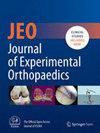Greater anterior pelvic tilt and lumbar mobility in females compared to males undergoing periacetabular osteotomy: A matched cohort study
Abstract
Purpose
The functional hip–spine interaction is increasingly noted in hip preservation by periacetabular osteotomy (PAO), while potentially affecting the impingement-free acetabular reorientation. However, the clinically relevant sex-related differences in lumbopelvic alignment have been poorly studied. Thus, the purpose of this study was to evaluate a matched PAO patient cohort for sex-related differences in lumbopelvic alignment.
Methods
Out of 138 patients undergoing PAO between January 2024 and September 2024 at one high-volume centre, there were 68 data sets (34 male, 34 female) included. The data sets of this diagnostic cohort study were prospectively collected, and the patients were matched in a 1:1 ratio for sex, age and acetabular morphology (hip dysplasia, borderline hip dysplasia, acetabular retroversion). Lumbopelvic alignment was assessed with serial sagittal lumbopelvic radiographs in standing, relaxed-seated and deep-seated positions. Each radiograph was reviewed for pelvic tilt (PT), lumbar lordosis and sacral slope.
Results
Females showed a significantly lower PT in standing (7.8 vs. 14.3°, p < 0.001), relaxed-seated (28.1 vs. 34.9°, p = 0.012) and deep-seated (3.7 vs. 11.0°, p = 0.013) positions. Furthermore, females had a significantly increased lumbar mobility (Δ relaxed-seated − deep-seated position − 35.4° vs. 27.0°, p = 0.003), while there was no sex-related difference in sacral mobility (p > 0.05).
Conclusion
There are sex-related differences in functional lumbopelvic alignment across various positions of daily living in patients undergoing PAO. With a greater anterior PT, females are at risk of an anterior hip impingement. Thus, the intraoperative anterior and posterior wall reorientation by PAO should be adapted to the sex-related lumbopelvic alignment to ensure an impingement-free surgical outcome.
Level of Evidence
Level IV, case series.


 求助内容:
求助内容: 应助结果提醒方式:
应助结果提醒方式:


